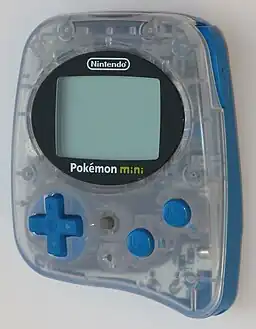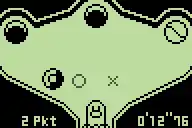Pokémon Mini
The Pokémon Mini[lower-alpha 1] (officially stylized as Pokémon mini) is a handheld game console that was designed and manufactured by Nintendo and themed around the Pokémon media franchise. It is the smallest game system with interchangeable cartridges ever produced by Nintendo,[5] weighing just under two and a half ounces (71 grams).[4] It was first released in North America on November 16, 2001, and was only available for purchase at the Pokémon Center and via its website.[6] This was followed by releases in Japan on December 14, 2001,[7] and in Europe on March 15, 2002.[8] The system was released in three colors: Wooper Blue, Chikorita Green, and Smoochum Purple.[2]
 "Wooper blue" Pokémon mini | |
| Manufacturer | Nintendo |
|---|---|
| Type | Handheld game console |
| Generation | Sixth |
| Release date | |
| Introductory price | ¥4,800[1] US$40[2] |
| Media | ROM cartridge |
| CPU | S1C88 @ 4 MHz |
| Memory | 4 KB RAM |
| Storage | 6 "files" on-board system memory[3] |
| Display | Monochrome LCD, 96 × 64 pixels[1] |
| Power | 1 AAA battery, up to 60 hours |
| Dimensions | 74mm × 58mm 23 mm (0.91 in) x 2.28in x 0.91 in)[4] |
| Mass | 70 g (2.5 oz) with cartridge and battery inserted[4] |
| Related | Pokémon Pikachu |
Features of the Pokémon mini include an internal real-time clock, an infrared port used to facilitate multiplayer gaming, a reed switch for detecting shakes, and a motor used to implement force feedback.[9] Only ten games were released worldwide, half of which were exclusive to Japan and one of which was only unreleased in North America.
Various hackers have reverse engineered the Pokémon mini in order to enable the creation of homebrew games, and to allow official games to be played on other platforms.
Technical details
- CPU 8-bit, 4 MHz Epson S1C88
- 96 x 64[1] pixel monochrome LCD
- Game Pak (512KiB cartridge)
- Internal BIOS of 4kB
- Internal RAM 4kB (shared with video subsystem)
- 21-bit cartridge bus
- 256 hardware register; in most cases Open-Bus registers
- Dimensions: 74 by 58 by 23 millimetres (2.91 in × 2.28 in × 0.91 in)[4]
- Weight: 70 grams (2.5 oz) with Game Pak and AAA battery inserted[4]
- Power: 1 AAA battery (lasting ~60 hours)
List of games
The games were published in Japan by The Pokémon Company and in other countries by Nintendo.
| Title | Genre | Developer[10][11] | Release date | ||
|---|---|---|---|---|---|
| JP | NA | PAL | |||
| Pokémon Party mini | Mini games | Denyusha | December 14, 2001 | November 16, 2001 | March 15, 2002 |
| Pokémon Pinball mini | Pinball | Jupiter | December 14, 2001 | November 16, 2001 | March 15, 2002 |
| Pokémon Puzzle Collection | Puzzle | Jupiter | December 14, 2001 | November 16, 2001 | March 15, 2002 |
| Pokémon Zany Cards | Strategy | Denyusha | December 14, 2001 | November 16, 2001 | March 15, 2002 |
| Pokémon Tetris | Puzzle | Nintendo | March 21, 2002 | Unreleased | March 15, 2002 |
| Pokémon Puzzle Collection vol. 2 | Puzzle | Jupiter | April 26, 2002 | Unreleased | Unreleased |
| Pokémon Race mini | Racing | Jupiter | July 19, 2002 | Unreleased | Unreleased |
| Pichu Bros. mini | Mini games | Denyusha | August 9, 2002 | Unreleased | Unreleased |
| Togepi's Great Adventure | Adventure | Jupiter | October 18, 2002 | Unreleased | Unreleased |
| Pokémon Breeder mini | Simulation | Jupiter | December 14, 2002 | Unreleased | Unreleased |

In all three regions the console was released, the Pokémon mini handheld launched with four (five in Europe) games that could be bought separately:
- Pokémon Party mini:[lower-alpha 2] A collection of several minigames, included with the Pokémon mini. The minigames include: "Hitmonchan's Boxing", where the player shakes the system to 'punch'; "Pikachu's Rocket Start", a game where the player has to launch off a starting line before another Pokémon; "Bellossom's Dance", a Dance Dance Revolution-like game; "Chansey's Dribble", in which the player kicks a ball to the finish line as quickly as possible; "Slowking's Judge", the player predicts if the tennis ball will land in or out of the court; and "Sneasel's Fakeout", a rock paper scissors-like game for two players. Additional modes include "Battlefield", where two to six players battle for the highest score in the aforementioned minigames, and "Celebi's Clock", a clock with date, alarm and stopwatch function.[2]
- Pokémon Pinball mini:[lower-alpha 3] A pinball game with several levels where a Pokémon, such as a Diglett or a Pikachu, acts as the 'bumping' mechanism.
- Pokémon Puzzle Collection:[lower-alpha 4] A collection of different puzzle-games, including "Motion Puzzle", a sliding game where a moving image of a Pokémon has to be unscrambled; "Shadow Puzzle", where different shapes are put together to make an image of a Pokémon; "Rescue Mission", where one has to move blocks to let a Pokémon out of a maze; and "Power On", a Pipe Dream-like game where one has to connect a Pikachu to a light bulb, creating a circuit).
- Pokémon Zany Cards:[lower-alpha 5] A small collection of four playing card games featuring Pokémon-themed cards and characters from the Pokémon anime.
Due to low sales, no further games for the system were released in North America.
One more game was then released in Japan and Europe:
- Pokémon Tetris[lower-alpha 6]: Tetris with Pokémon. In addition to traditional piece rotation, shaking the system will cause falling pieces to flip. Clearing lines will unlock Pokémon from Pokémon Gold and Silver in the Pokédex.
All subsequent games were only released in Japan, though all five eventually received fan translations:
- Pokémon Puzzle Collection vol. 2:[lower-alpha 7] A sequel to Pokémon Puzzle Collection. It features new "Pick-Up Puzzle" and "Stretch Puzzle" game types, along with the returning "Motion Puzzle" and "Shadow Puzzle".
- Pokémon Race mini:[lower-alpha 8] A platform racing competition where the player controls a Pikachu racing against other Pokémon.
- Pichu Bros. mini:[lower-alpha 9] A sequel to Pokémon Party mini. It features six new minigames: "Skate Pichu, "Magby's Hot-Air Balloon", "Hoppip's Jump", "Teddiursa's Shaking Fruits", "Smoochum's Angel Kiss", and "Cubone's Bone Club Fight", along with the returning "Battlefield" and "Clock" modes.
- Togepi's Great Adventure:[lower-alpha 10] A top-down action puzzle game. The player guides Togepi out of a tower while avoiding traps.
- Pokémon Breeder mini:[lower-alpha 11] A virtual pet game. The player cares for a young Treecko, Torchic or Mudkip.
Legacy
The 2002 Nintendo GameCube game Pokémon Channel features an in-game Pokémon Mini that can be unlocked.[12] By purchasing new games from the in-game store, the player can access playable emulated demo versions of Pokémon Mini games, including "Snorlax's Lunch Time", a minigame that was never part of any commercial Pokémon Mini release.[13]
By reverse engineering the Pokémon Channel emulator, hobbyist software engineers were able to gain a better understanding of how the system worked. This allowed them to build new emulators to run the games on other devices, such as the PC, Dreamcast, Nintendo 3DS, and Analogue Pocket, among others.[14] These efforts also led multiple programmers to create homebrew applications for the system, such as original games and tech demos.[13] A demo, SHizZLE, was released at Breakpoint in 2005 and caused some excitement within the demoscene and media.[5] In 2022, independent developer Sungrand Studios launched a Kickstarter campaign to develop a port of their horror game Silver Falls for the system.[15]
Notes
- Japanese: ポケモンミニ
- Japanese: ポケモンパーティミニ
- Japanese: ポケモンピンボールミニ
- Japanese: ポケモンパズルコレクション
- Japanese: ポケモンアニメカード大作戦, Hepburn: Pokemon Anime Kādo Daisakusen, lit. Pokémon Anime Card Great Strategy
- Japanese: ポケモンショックテトリス, Hepburn: Pokemon Shokku Tetorisu, lit. Pokémon Shock Tetris
- Japanese: ポケモンパズルコレクションVol.2
- Japanese: ポケモンレースミニ
- Japanese: ピチューブラザーズミニ
- Japanese: トゲピーのだいぼうけん, Hepburn: Togepī no Daibōken
- Japanese: ポケモンそだてやさんミニ, Hepburn: Pokemon Sodateyasan mini
References
- "Pokemon Mini". 4 September 2001.
- "Pokemon Mini In-Hand". 22 November 2001.
- Pokémon mini Instruction Booklet. Nintendo of America. 2001. p. 20.
- Pokémon mini Instruction Booklet. Nintendo of America. 2001. p. 27.
- "Rediscovering Nintendo's Forgotten Console, the Pokémon Mini". 10 September 2015.
- "Pokemon Mini Hits the US". 15 November 2001.
- ハマるゲームが目白押し! ポケモンミニ体験レポート (in Japanese). Nintendo. Archived from the original on 2002-12-16. Retrieved 2009-02-25.
- "Nintendo History". Nintendo of Europe. Archived from the original on 2012-09-04. Retrieved 2009-08-19.
2002: [...] Pokémon mini, the world's smallest console, was launched on 15 March across Europe with four titles, including Pokémon mini Party and Pokémon mini Pinball.
- "Pokémon Mini". Retro Magazine. No. 81. Imagine Publishing. October 2010.
- "Denyusha Consumer Games". Denyusha. Archived from the original on 2013-01-16. Retrieved 2009-02-24.
- "Jupiter Game Software-Pokémon mini". Jupiter. Archived from the original on 2013-05-02. Retrieved 2009-02-24.
- Irwin, Mary Jane (December 4, 2003). "Pokemon Channel: Watch TV thanks to your GameCube". IGN. Archived from the original on March 3, 2012. Retrieved January 27, 2014.
- "Hardware Classics: Pokémon Mini". 30 June 2016.
- "You'll be Able to Play Pokémon Mini on the Analogue Pocket Soon". 12 October 2022.
- "Random: Indie Horror Dev Launches Kickstarter to Create a Game for Pokémon Mini". 16 May 2022.
External links
- Pokémon mini page on Nintendo's official Japanese site (in Japanese)
- Pokémon-Mini.net - Pokémon Mini Database and Dev Site by Team Pokémé
- Pokémon mini development Wiki (technical information)
- Pokémon Mini at NinDB